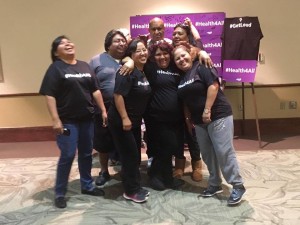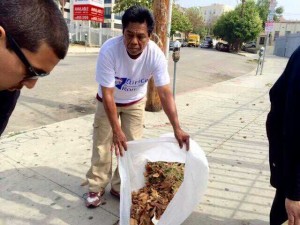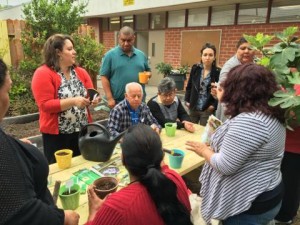Organization: Clínica Monseñor Oscar A. Romero | Los Angeles, CA | Community Health Center Program – 330(e) | www.clinicaromero.com
Contact: Ana Grande, Community Organizing Director, agrande@clinicaromero.com
“Our goal is to look at public health indicators that are affecting the population, implement an assessment, and engage our patient population in becoming a voice for themselves and their community.” –Ana Grande, Community Organizing Director
Clínica Monseñor Oscar A. Romero is a Health Resources and Services Administration (HRSA) supported Health Center Program Grantee located in the city of Los Angeles, California. Founded in 1983 by a group of Salvadoran refugees, the health center, commonly referred to as Clínica Romero, provides culturally sensitive, quality health services to marginalized communities, in particular immigrants or those of immigrant descent. Clínica Romero serves approximately 12,000 patients annually through two sites that are located in the neighborhoods of Boyle Heights and Pico-Union.

Clínica Romero strives to reduce barriers to care and ensure access to comprehensive health services by functioning as a “one-stop-shop.” Collectively, the clinics offer general family practice, pediatric care, prenatal and post-partum care, women’s health, mental health and substance abuse counseling, dental care, optometry services, and a pharmacy.
To further support its patient population, Clínica Romero has maintained a Community Organizing Department from its inception. The current department is comprised of five staff: a director, a manager, one program lead, and two organizers, both of whom are former promotoras. Department staff are funded by a private health foundation. The services the department offers, such as the promotoras program, are financially sustained through a variety of external grants. Although the structure and responsibilities of the department have evolved, the purpose remains the same: to engage, capacitate, and empower the health center’s patient population to become advocates for the health of themselves and their communities. The following are key examples of the processes used to achieve this outcome:
 Patient Engagement Committee: Department staff facilitate the Mi Vida! Mi Salud! Right to Health Committee. The intent of the committee is threefold: to provide patients with an outlet to voice their concerns about community needs, to cultivate community leaders, and to guide the advocacy and policy efforts of the Community Organizing Department.
Patient Engagement Committee: Department staff facilitate the Mi Vida! Mi Salud! Right to Health Committee. The intent of the committee is threefold: to provide patients with an outlet to voice their concerns about community needs, to cultivate community leaders, and to guide the advocacy and policy efforts of the Community Organizing Department.
Promotora Program: Under the leadership of the current director, the Community Organizing Department has successfully implemented a promotora model for community outreach and engagement efforts. Within its first year, the department had 56 promotoras working on campaigns; there are currently 40 active promotoras.
Potential promotoras are recruited from the Mi Vida! Mi Salud! patient committee. Individuals who are the most vocal or who have the most questions are invited by department staff to train as promotoras. Community members may also volunteer as promotoras.
All promotoras are trained and evaluated by the Community Organizing Department; training depends on the assigned project. Promotoras who will conduct basic education outreach, such as prenatal care or cancer screenings, undergo a one-day training (4-6 hours) consisting of several modules. The promotoras are tested after each module to ensure that they fully comprehend the material. Promotoras that conduct more intensive outreach efforts, such as workshops, participate in a series of professionalization trainings that are delivered over the course of three to six months. The director of the department, who is also a college professor, developed the curricula used in these trainings. Upon completion of the training, each promotora receives a certificate of award and a stipend that corresponds to their assigned project.
 One example that illustrates the success of the promotora program is the Health4All Kids Campaign. A statewide initiative, the campaign was instrumental in securing funding and enactment of legislation (SB 4) at the state level to expand full-scope Medi-Cal coverage to all children younger than 19 years in California, regardless of immigration status. Due to their significant contributions to the Health4All Kids Campaign, the Community Organizing Department at Clínica Romero received a grant from Los Angeles Mayor Eric Garcetti to continue their advocacy efforts for the similar but separate Health4All Campaign, which seeks to ensure that all undocumented adults in California have access to affordable, quality heath insurance. This grant provides sufficient funding to have twenty-four promotoras dedicated to conducting outreach and education in support of the campaign.
One example that illustrates the success of the promotora program is the Health4All Kids Campaign. A statewide initiative, the campaign was instrumental in securing funding and enactment of legislation (SB 4) at the state level to expand full-scope Medi-Cal coverage to all children younger than 19 years in California, regardless of immigration status. Due to their significant contributions to the Health4All Kids Campaign, the Community Organizing Department at Clínica Romero received a grant from Los Angeles Mayor Eric Garcetti to continue their advocacy efforts for the similar but separate Health4All Campaign, which seeks to ensure that all undocumented adults in California have access to affordable, quality heath insurance. This grant provides sufficient funding to have twenty-four promotoras dedicated to conducting outreach and education in support of the campaign.
The promotora model benefits not only the community but the health center as well. In 2015, department staff and trained promotoras reached more than 12,000 community members through their outreach efforts. The result of these interactions was an increase of 1,500 patients for Clínica Romero.
 Patient Stories: The Community Organizing Department has implemented a practice of collecting patient stories to document the impact of their advocacy efforts. Trained promotoras identify patients and community members who are directly affected by the policies that the outreach campaigns seek to change. These individuals are interviewed and their stories are saved in a story bank maintained by the department. The stories provide invaluable perspective and supplement the quantitative data collected by staff.
Patient Stories: The Community Organizing Department has implemented a practice of collecting patient stories to document the impact of their advocacy efforts. Trained promotoras identify patients and community members who are directly affected by the policies that the outreach campaigns seek to change. These individuals are interviewed and their stories are saved in a story bank maintained by the department. The stories provide invaluable perspective and supplement the quantitative data collected by staff.
The Community Organizing Director recommends that health centers or organizations interested in starting a similar department start small with well-defined processes and outcomes in place from the beginning. All too frequently, departments are started and abandoned within one year because outcomes fell below expectations. One tip for success is making certain that there is alignment between health center leadership and the department staff regarding what policies will be advocated for internally and externally. In the director’s experience, it takes a minimum of five years to establish a strong, sustainable organizing department. For her, it is about elevating the experience of patients: “make sure to leverage the voice of your patients to be a louder voice in the community…[at Clínica Romero] they feel really empowered when we give them that capacity, that encouragement to really say this is what I am going through and I want my voice to be heard.” Just as a health center remains patient-focused and patient-driven, so must an effective and impactful community-organizing department.
Disclaimer
This report was supported by the Health Resources and Services Administration (HRSA) of the U.S. Department of Health and Human Services (HHS) under grant number U30CS09743, a National Training & Technical Assistance Cooperative Agreement, in the amount of $770,259. This information or content and conclusions are those of the author and should not be construed as the official position or policy of, nor should any endorsements be inferred by HRSA, HHS or the U.S. Government.
